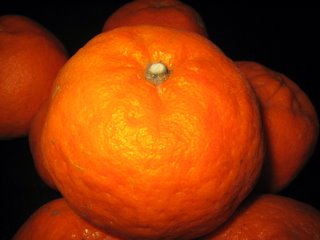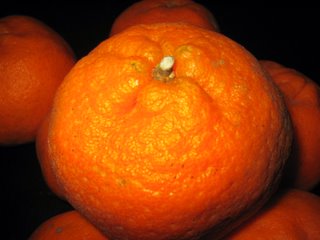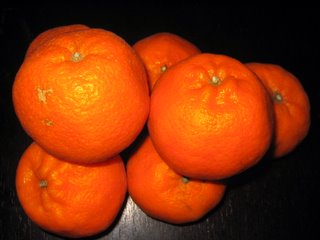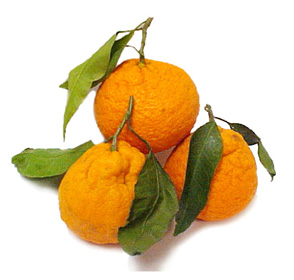
Comes CNY and everyone of us will flock to the hypermarket or any place that does sells this fruit.
Anyone knows why we are eating this? The origin ? etc ?
Long list of things and not sure if anyone had ever post about this.
According to Wikipedia Mandarin Orange is a small citrus tree (Citrus reticulata) with fruit resembling the orange. Eh ? I thought they were oranges - chuckle
From another source, HortEdu will tell you more about the cultivars of Mandarin Oranges. Too much information for me to digest and post it here. CNY laziness. lolz
So, which cultivars do we have here in Malaysia ?
In simpler days, there were tangerines. Now there are Mandarins, of which there are four main types: the Satsumas of Japan (Citrus unshiu), the Mediterranean Mandarins of Europe (Citrus deliciosa), the King Mandarins of Asia (Citrus nobilis) and the "common" Mandarins (Citrus reticulata). Of all, the Satsumas and the common types are most grown in the U.S. The former are particularly cold-hardy (to 24 o F), so appreciated in more marginal citrus-growing regions. The common kinds include the popular Clementines. "Tangerine," it turns out, was a marketing term that has no bearing on actual varieties but is applied to many Mandarins and Mandarin hybrids.
(The above paragraph is copied from DOITYOUSELFdotCOM)
The mandarin orange is a native of south east Asia and the Philippines. They have been grown in China for over 3,000 years. Their name comes from the bright orange robes worn by mandarins, public officials of the ancient Chinese court. Mandarin oranges did not reach Europe and North America until the 1800's. The first mandarin oranges to be exported were shipped from the city of Tangiers in Morocco, which is how they became known as tangerines.
Ranging in sizes , taste from sour to sweet, seedless to a few seeds , they are united by only their loose and easy to peel rind. Another uniting factor is their segment. They separates easily.
The mandarin orange is at its best when the fruit is unblemished and a bit heavy for its size and free of spots, mold and overly soft areas. Most frequently eaten out of hand, with no enhancements necessary, mandarins can also be added to fruit salads, sauces and are simply splendid in sweet and sour dishes. Used to decorate cakes, puddings and pies, mandarins also add a unique touch to main courses when you want a bit of zesty flavor to enliven the dish. And then there’s the peel…less bitter than oranges, the peel requires less pressure when zesting and adds a delicately sweet flavor to any dish.Oranges symbolize good fortune because they are sweet and one of China's most abundant fruits. The word Kam sounds similar to Cantonese for gold. Since they are sweet and have an auspicious meaning, they are a must for CNY. Traditionally, in Chinese culture, Mandarin orange symbolizes long life. It was presented to people with the stem and leave intact as they symbolizes longlife.
All kinds of mandarin oranges can be eaten fresh. You can also use the sections of this citrus fruit in fruit salads, gelatins, puddings, or on cakes. Some of the mandarin types are also canned in syrup
Not only the juice, but also the other sections of the fruit are very useful. The peel provides an essential oil that helps in flavoring candy, gelatin and ice cream or any bakery goods that require orange flavor. Another mandarin oil called Petitgrain also has the same application. This oil is extracted from the leaves, twigs and unripe fruits of the mandarin.
Looking around and I come to believe that the mandarin oranges that we usually buy is called Willow-Leaf Mandarin Orange or China Mandarin Orange. They are oblate to round in shape, smooth, glossy, thin; pulp orange, with 10-12 segments; very juicy, of sweet, rich flavor; 15-20 seeds or it can be seedless.
Normally comes from 2 region of China - ZhangZhou and YongChun. They are usually called Lokam here in Malaysia. Cant seems to find the Teo Chew or Chiu Chao Mandarin information.
Dont know what else to write here and the idea here is actually telling how to choose sweet oranges.
Tips to buy mandarin oranges
Look for: Firm and heavy oranges with fresh, bright-looking skin which is reasonably smooth for the variety
Avoid: Light-weight oranges, which are likely to lack flesh content and juice. Very rough skin texture indicates abnormally thick skin and less flesh. Dull, dry skin and spongy texture indicate aging and deteriorated eating quality. Also avoid decay -- shown by cuts or skin punctures, soft spots on the surface, and discolored, weakened areas of skin around the stem end or button.
Sizes
To be categorized by its cross section diameters
a) 65 – 70mm Small b) 70 – 75mm Medium c) 75 – 80 mm Large d) 85 – 90mm Xtra Large

See the crinkle skin( is it called the crown ??) on top of the oranges. As per elders, this indicate the orange is sweet. True ? Try them out and see.
This indicates a so so orange. I still dont know whether it is true. Chuckle
Various shape and sizes of oranges from the same ZhangZhou orange that comes in a carton.
The blesmishes on the skin doesnt affect the taste. Indeed they said, it will be a sweeter orange than most. Anyone wants to try and let us know ?
The Satsuma Mandarin - supposedly the sweetest mandarin orange around. Look at the crown. High, eh ?
Cheers !
Thanks for the tips - will use it when I need to stock up. On the first day of CNY, I brought mandarin oranges to my cousin's open hse and gave my aunties and cousins - went with 20 big ones, came back with 6 small ones! So far, the nice ones I have had are the Taiwan Lokam and the tangerines.
ReplyDeletehehehehe! The Taiwan lokam is sweet, Love them. ate 2 and i got sore throat till now. 4 days now. Terrible.
ReplyDeleteSteamboat is easier , no cooking required and less dish washing. abundanace leftover that my lil sis though she's 26 now - chuckle had been eating for the last 3 days.
She loves steamboat though
nice oranges..
ReplyDeletehappy chinese new year!
interesting writeup on the "kum" :)
ReplyDeleteI mostly wanted to do similar writeup. but due to lack of time, work, preparations keeping me too busy to do this.
I mostly buy Pakistan Kinno nowadays. There are sweet, juicy & easy to peel. they have nice & smooth skin as well. the downside is that they don't keep well for long and have to be refrigrated.
u too NKW
ReplyDeleteSlurp, pakistan kinno ? er...dont really know it. In fact, i didnt even really know what i wanted to post. Did some research ask around and sort of a haphazard write up.
which type of tangerines are these?
ReplyDeletePic1 and Pic2
i can't seem to differentiate them. they're confusing me now with ponkam, lokam, teow chew kam... i just gasak any kam! :D
ReplyDeletelolz
ReplyDeleteWah, never knew the "kam" had such a long story wor. Last year I was sick and so I didn't manage to eat any kams. This year coughing again and didn't get to eat much either. *pouts* So sad...
ReplyDeleteDaddy nick, i really dont know. Thanx for dropping by.
ReplyDeleteFran, drink more plain water. Eat less all those baked and fried goods. Forget about the mandarin orange. Maybe u can take one if you stop all those naked and fried goods.